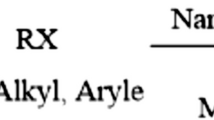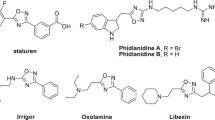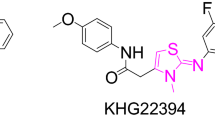Abstract
Novel bis(nitroepoxides) were prepared based on terephthaldehyde and isophthaladehyde and their reactions with diversities of nucleophiles such as primary and secondary amine-based dithiocarbamic acids, xanthates, and ammonia-based dithiocarbmamates were investigated for the synthesis of bis(thiazolidine-2-thiones), bis(dithiocarbamates), bis(xanthates) and bis(thiazoles), respectively. It provides simple access to complex molecules in one step in high to excellent yields.
Similar content being viewed by others
The synthesis and chemistry of α-nitroepoxides were first developed by Newman and Angier in 19691,2 Since then, although sporadic reports have been published about the application of nitroepoxides in organic synthesis3, the major research on these compounds has accelerated since 2011, when Tsogoeva et al. reported the reaction of these compounds with thioamides for the synthesis of 1,3-thiazoles4. In general, nitroepoxides are small molecules having two electrophilic centers. This unique characteristic makes nitroepoxides as efficient substrates in the reactions with mono- and dinucleophiles. Beside N/O/S-mononucleophiles, diversities of N, C-, N, N-, and N, S-dinucleophiles were applied extensively for the synthesis of various heterocycles including thiazoles5, pyrroles6, imidazoles7, and triazolothiadiazines8, quinoxalines, benzodiazepines, imidazopyridines, and pyrazines9,10.
Among various sulfur nucleophiles, xanthate and dithiocarbamic acid salts have been well investigated in recent years and were applied successfully in the reactions with various electrophiles including alkyl halides11, epoxides,12,13 electron-rich and -deficient alkenes,14,15 alkynes16, aldehydes17, oximes18 and diazo compounds19. Although xanthates are very good sulfur mononucleophiles, but dithiocarbamic acids prepared from primary and secondary amines are potential mono- and bis-nucleophiles with S, S and S, N atoms20,21 In addition, ammonia-based dithiocarbamates are efficient N, S-dinucleophiles for the synthesis of N, S-heterocyclic compounds21,22,23,24.
Results and discussion
Recently, we investigated the reaction of sulfur nucleophiles with simple nitroepoxides25,26 These results encourage us to investigate the possibility of preparation of bis(nitroepoxides) and using them in the reaction with some sulfur nucleophiles. According to the best of our knowledge, there is no report for the synthesis of bis(nitroepoxides) in literature. Consequently, we decided to prepare bis(nitroepoxides) 3a, b from terephthaldehyde and isophthaldehyde. For this purpose, the corresponding nitroalkenes 2a (82%) and 2b (72%) were prepared from 1a, b and nitroethane in acetic acid and catalytic amount of n-butyl amine and then were applied in epoxidation reaction with H2O2/NaOH to afford the target bis(nitroepoxides) 3a and 3b in 85% and 76% yields, respectively (Fig. 1).
After successful synthesis of bis(nitroepoxides), the one-pot pseudo-five-component reaction of 3a with benzyl amine and CS2 was investigated to find the optimal conditions. After examination of various conditions (See Table 1 in supporting information for details), we observed that by mixing benzyl amine (3.6 equiv) and carbon disulfide (6 equiv) in ethanol at room temperature for 30 min, followed by the addition of bis(nitroepoxides) 3a (1 equiv) and further stirring in reflux condition for 8 h, the product 4a was obtained in 88% isolated yield. The replacement of EtOH with other solvents such as THF, CHCl3, DMF, H2O and neat conditions afforded unsatisfactory yields of 4a. In addition, no improvement in reaction yield was observed by varying the stoichiometric amount of the starting materials. Under optimized reaction conditions, the scope of the reaction was investigated by the reaction of primary amines such as benzylamine, ethylamine, propylamine and isobutylamine with bis(nitroepoxides) 3a and 3b and all gave high to excellent yields of bis-thiazole-2(3H)-thiones 4a-e (Fig. 2).
It is well documented that the biological activity of dithiocarbamate-containing molecules depends on the number of dithiocarbamate moieties in the scaffolds and can be improved by increasing the number of dithiocarbamate motifs27. For this purpose, we have shown that the reaction of bis(nitroepoxides) with in situ prepared secondary amine-based dithiocarbamic acids under optimized reaction conditions described above afforded the corresponding bis(dithiocarbamates) 5 in high to excellent yields (Fig. 3). Various secondary amines such as dimethylamine, diethylamine, dibutylamine, morphiline, pyrrolidine, and piperidine were applied successfully in the reaction with bis(nitroepoxides) 3a and 3b to afford bis(dithiocarbamates) 5a-l in excellent yields (Fig. 3). In contrast to dithiocarbamic acid prepared from primary amines which react as bisnucleophiles from S- and N-atoms, those prepared from secondary amines play as mononucleophile from their sulfur atom.
In continue, reactions of bis(nitroepoxides) with ammonia-based dithiocarbamates 6 were carried out to prepare the corresponding bis(thiazoles) 7. Initially, ammonia-based dithiocarbamates were prepared via a one-pot three-component reaction of ammonia, CS2 and an alkyl halide in pyridine23. Then, various reaction conditions were tested to optimize the reaction conditions and finally mixing an equivalent of a bis(nitroepoxide) with two equivalents of an ammonia-based dithiocarbamate in EtOH in reflux conditions for 8 h was considered as optimal reaction conditions for further derivatization. Under these conditions, bis(thiazoles) 7a-g were prepared in high to excellent yields (Fig. 4).
Finally, reaction of bis(nitroepoxides) 3a, b with potassium xanthates 8 were investigated for the synthesis of bis(xanthates) 9. Reaction of potassium O-methyl carbonodithioate (2.4 equiv) with 3a (1 equiv) was screened in various solvents at room temperature and the best yield was obtained in water (91%) and ethanol (87%). However, water was selected as the reaction solvent for further derivatization with respect to the principles of green chemistry. Under optimized conditions, the scope of the reaction was evaluated using various potassium xanthates prepared from primary and secondary alcohols such as methanol, ethanol, 1-propanol, 1-butanol and 2-butanol and all afforded the corresponding bis(xanthates) 9a-e in 84–91% isolated yields (Fig. 5). Attempt to get suitable products with using 3b was unsuccessful.
Proposed mechanisms for the formation of products are depicted in Fig. 6. In the case of products 4 and 5, the reaction of in situ prepared dithiocarbamic acids with bis(nitroepoxide) afforded the corresponding intermediate II (in the case of primary amines) or 5 (in the case of secondary amines) after elimination of HNO2. While the reaction stops in this step for the secondary amines, for dithiocarbamic acids based on primary amines, intramolecular addition of nitrogen to the carbonyl group provided the hemiaminal intermediate III, which underwent dehydration reaction to afford the corresponding bis-thiazole-2(3H)-thione 4. For ammonia-based dithiocarbamates, the epoxide ring opening with the sulfur of thiocarbonyl group is the first event to furnish the intermediate V after elimination of nitrous acid, followed by intramolecular addition of nitrogen to the carbonyl group to provide the intermediate VI. Aromatization by the elimination of water afforded the product 7. A similar mechanism can be proposed for bis(xanthates) formation.
Experimental
General
All chemicals and solvents were obtained from commercial sources and used as received. The1H and13C NMR spectra of products were recorded on a Bruker AMX 300 and 500 MHz spectrometers referenced to internal Me4Si at 0.00 ppm. Reaction monitoring was carried out by thin-layer chromatography using TLC silica gel 60 F254 plates. HRMS (High Resolution Mass Spectra) was measured on a THERMO SCIENTIFIC Advantage and a THERMO SCIENTIFIC Exactive instrument equipped with an APCI source in the positive-ion mode. IR spectra were recorded on a Perkin-Elmer Spectrum RXI FT-IR spectrometer. Elemental analyses were conducted with a Perkin-Elmer 2004 Series II CHN analyzer.
General procedure for the synthesis of 1,3- and 1,4-bis(nitroolefins) ( 2a and 2b)
A solution of nitroethane (30.00 mmol), n-butylamine (20.00 mmol) and terephthalaldehyde (10.00 mmol) or isophthalaldehyde (10.00 mmol) in acetic acid (7 mL) were stirred at 70 °C for 90 min. Then, the reaction mixture was cooled and filtered. The precipitate was crystallized in hot methanol to give pure products 2a and 2b in 82% and 72% isolated yields, respectively.
General procedure for the synthesis of 1,3- and 1,4-bis(nitroepoxides) (3a-b)
Bis(nitroalkene) 2a or 2b (7.00 mmol) was added to a round bottom flask containing methanol (25.00 mL). Then, hydrogen peroxide (50%, 16.00 mmol) was added to the reaction mixture at 0–5 °C, followed by drop-wise addition of aqueous sodium hydroxide (2 M, 0.5 mL) at the same temperature. Then, the reaction mixture was further stirred for 15 min at room temperature. At the end, the white precipitate was formed, filtered and washed several times with distilled water to afford the target products 3a and 3b in 85% and 76% isolated yields, respectively.
General procedure for the synthesis of bis(thiazole-2(3 H)thiones) (4a-e)
To a solution of a primary amine (0.9 mmol) in EtOH (2.5 mL), CS2 (1.5 mmol) was added and the mixture was stirred for 30 min at room temperature. Then, a bis(nitroepoxide) (0.25 mmol) was added and the resulting mixture was refluxed for 8 h. The reaction was quenched with water (10 mL) and was extracted with ethyl acetate (3 × 5 mL). The organic layers were combined, washed with brine and dried over Na2SO4. After evaporating of the solvent, the residue was purified by column chromatography (silica gel, n-hexane /ethyl acetate; 3:1).
General procedure for the synthesis of bis(dithiocarbamates) (5a-l)
To a solution of a secondary amine (0.9 mmol) in EtOH (2.5 mL), CS2 (1.5 mmol) was added and the mixture was stirred for 30 min. Then, a bis(nitroepoxide) (0.25 mmol) was added and the resulting mixture was stirred at reflux temperature for 8 h. The mixture was quenched with water (10 mL) and extracted with ethyl acetate (3 × 5 mL). The organic layers were combined, washed with brine and dried over Na2SO4. After evaporating of the solvent, the residue was purified by column chromatography (silica gel, n-hexane / ethyl acetate; 3:1).
General procedure for the synthesis of bis(thiazoles) (7a-g)
To a solution of bis(nitroepoxide) (0.50 mmol) in ethanol (3 mL) was added an ammonia-based dithiocarbamate 6 (1 mmol). The reaction mixture was stirred at reflux conditions for 8 h. After cooling to 0–5 oC, the precipitate was filtered and washed with cold diethyl ether to remove any impurities.
General procedure for the synthesis of bis(xanthates) (9a-e)
1.2 mmol of a xanthate salt was added to a solution of 1,4-bis(nitroepoxide) (0.50 mmol) in 5 mL of water and the reaction mixture was stirred for 8 h at ambient temperature. After cooling the reaction mixture, the precipitate formed. The precipitate was washed several times with water and petroleum ether to afford the pure product.
Conclusion
In conclusion, we developed an efficient method for the synthesis of bis(nitroepoxides) based on terephthaldehyde and isophthalaldehyde. In addition, the synthetic utilities of the prepared bis(nitroepoxides) were evaluated in the reaction with selected sulfur nucleophiles such as primary and secondary amine-based dithiocarbamic acids, xanthates, and ammonia-based dithiocarbmamates for the synthesis of bis(thiazolidine-2-thiones), bis(dithiocarbamates), bis(xanthates) and bis(thiazoles), respectively. We have shown that the prepared bis(nitroepoxides) are efficient intermediates for the synthesis of valuable N, S-heterocyclic compounds and dithiocarbamate(xantyl)-substituted phenyl 2-propanones (P2P derivatives). It is notable that all the dimer products were prepared with high to excellent yields without using any catalysis or any high-cost and toxic materials and solvents. In all cases, the reaction starts by epoxide ring opening with the sulfur of the dithiocarbamate or xanthate, followed by intramolecular hemiaminalization, and dehydration reactions cascade in the case of primary amine-based dithiocarbamic acids and ammonia-based dithiocarbaamtes to afford the corresponding heterocyclic compounds. In addition, the projects related to the application of bis(nitroepoxides) for the synthesis of polymers and other heterocyclic compounds are running in our laboratory.
Data availability
All data generated or analyzed during this study are included in this published article [and its supplementary information file].
References
Newman, H. & Angier, R. B. α-Nitro-epoxides, a new class of compounds. J. Chem. Soc. D Chem. Commun. 369–370. https://doi.org/10.1039/C29690000369 (1969).
Newman, H. & Angier, R. B. The preparation and chemistry of α-nitroepoxides, Tetrahedron 26, 825–36. (1970). https://doi.org/10.1016/S0040-4020(01)97880-9
Vankar, Y. D., Shah, K., Bawa, A. & Singh, S. P. Chemistry of α-nitroepoxides: synthesis of useful intermediates via nucleophilic ring opening of α-nitroepoxides. Tetrahedron. 47, 8883–8906. https://doi.org/10.1016/S0040-4020(01)81002-4 (1991).
Weiß, K. M., Wei, S. & Tsogoeva, S. B. Novel one-pot process for the synthesis of 1, 3-thiazoles via organocatalysed epoxidation of nitro-olefins. Org. Biomol. Chem.9, 3457–3461. https://doi.org/10.1039/C1OB05260H (2011).
Zhao, D., Guo, S., Guo, X., Zhang, G. & Yu, Y. Facile, efficient synthesis of polysubstituted thiazoles via α-nitroepoxides and thioureas. Tetrahedron. 72, 5285–5289. https://doi.org/10.1016/j.tet.2016.05.010 (2016).
Zhao, D. et al. A three-component one-pot synthesis of penta-substituted pyrroles via ring opening of α-nitroepoxides. Tetrahedron. 73, 2872–2877. https://doi.org/10.1016/j.tet.2017.03.074 (2017).
Guo, X. et al. One-pot three-component strategy for functionalized 2-aminoimidazoles via ring opening of α-nitro epoxides. Org. Lett.17, 1157–1159. https://doi.org/10.1021/acs.orglett.5b00289 (2015).
Mohammadlou, M. & Ziyaei Halimehjani, A. Regio-and Diastereoselective synthesis of substituted triazolo [3, 4-b] thiadiazin-6-ols and triazolo [3, 4-b] thiadiazines. Synthesis. 55 (A-K). https://doi.org/10.1055/a-2017-4814 (2023).
Vidal-Albalat, A., Rodriguez, S. & Gonzalez, F. V. Nitroepoxides as versatile precursors to 1, 4-diamino heterocycles. Org. Lett.16, 1752–1755. https://doi.org/10.1021/ol500444z (2014).
Nosood, Y. L., Halimehjani, Z., Gonzalez, F. V. & A. & Regioselective opening of Nitroepoxides with Unsymmetrical Diamines. J. Org. Chem.83, 1252–1258. https://doi.org/10.1021/acs.joc.7b02795 (2018).
Azizi, N., Aryanasab, F. & Saidi, M. R. Straightforward and highly efficient Catalyst-Free One-Pot synthesis of dithiocarbamates under Solvent-Free conditions. Org. Lett.8, 5275–5277. https://doi.org/10.1021/ol0620141 (2006).
Ziyaei Halimehjani, A. et al. Investigation of the reaction of dithiocarbamic acid salts with trimethyl orthoformate and styrene epoxide. Tetrahedron Lett.56, 7124–7127. https://doi.org/10.1016/j.tetlet.2015.11.033 (2015).
Ziyaei Halimehjani, A., Hooshmand, S. E. & Vali Shamiri, E. Synthesis of α-phthalimido-α’-dithiocarbamato propan-2-ols via a one-pot three-component epoxide ring opening. Tetrahedron Lett.55, 5454–5457. https://doi.org/10.1016/j.tetlet.2014.08.017 (2014).
Azizi, N., Aryanasab, F., Torkian, L., Ziyaei, A. & Saidi, M. R. One-Pot synthesis of Dithiocarbamates Accelerated in Water. J. Org. Chem.71, 3634–3635. https://doi.org/10.1021/jo060048g (2006).
Ziyaei Halimehjani, A. & Hosseinkhany, S. A one-pot three-component route for the synthesis of rhodanine derivatives in water. Synthesis. 47, 3147–3152. https://doi.org/10.1055/s-0034-1380454 (2015).
Ziyaei Halimehjani, A. & Breit, B. Catalyst-free hydrothiolation of alkynes with dithiocarbamic acids. Chem. Commun.55, 1253–1255. https://doi.org/10.1039/c8cc09726g (2019).
Ziyaei Halimehjani, A., Hajiloo Shayegan, M., Hashemi, M. M. & Notash, B. Investigation of the reaction of Dithiocarbamic Acid salts with aromatic aldehydes. Org. Lett.14, 3838–3841. https://doi.org/10.1021/ol301598u (2012).
Zhu, Z. et al. Copper-catalyzed synthesis of thiazol-2-yl ethers from oxime acetates and xanthates under redox-neutral conditions. Chem. Commun.54, 3767–3770. https://doi.org/10.1039/C8CC00445E (2018).
López-Mendoza, P. & Miranda, L. D. α-Xanthylmethyl ketones from α-Diazo ketones. Synthesis. 53, 3777–3790. https://doi.org/10.1055/a-1513-9968 (2021).
Foumeshi, M. K., Halimehjani, Z., Alaei, A., Klepetářová, A., Beier, P. & B. & Tandem alkylation/Michael addition reaction of dithiocarbamic acids with alkyl γ-bromocrotonates: Access to functionalized 1, 3-thiazolidine-2-thiones. Synthesis. 2219–2228. https://doi.org/10.1055/a-1372-1619 (2021).
Ziyaei Halimehjani, A., Maleki, H. & Saidi, M. R. Regiospecific iodocyclization of S-allyl dithiocarbamates: synthesis of 2-imino-1,3-dithiolane and 2-iminium-1,3-dithiolane derivatives. Tetrahedron Lett.50, 2747–2749. https://doi.org/10.1016/j.tetlet.2009.03.127 (2009).
Ane, A. et al. Synthesis of thiaazaheterocycle nucleoside analogues. Nucleosides, Nucleotides and Nucleic Acids. Nucleosides, Nucleotides and Nucleic Acids. 21, 335–360. (2002). https://doi.org/10.1081/NCN-120006829
Ziyaei Halimehjani, A. & Airamlounezhad, S. ZrCl4/TMSCl as an efficient Catalyst for synthesis of 4, 6-Substituted 2‐Alkylthio‐6H‐1, 3‐thiazines. J. Hetcocycl Chem.51, 1147–1150. https://doi.org/10.1002/jhet.1526 (2014).
Moghaddam, F. M. & Goudarzi, M. Utility of N-Bromosuccinimide–Water Combination as a Green Reagent for Synthesis of N, S-Heterocycles and Dithiocarbamates from Styrenes, Synlett 31, 1823–1827. (2020). https://doi.org/10.1055/s-0040-1707258
Ziyaei Halimehjani, A. & Lotfi Nosood, Y. Synthesis of N, S-heterocycles and dithiocarbamates by the reaction of dithiocarbamic acids and S-alkyl dithiocarbamates with nitroepoxides. Org. Lett.19, 6748–6751. https://doi.org/10.1021/acs.orglett.7b03501 (2017).
Badali, E., Rahimzadeh, H., Sharifi, A. & Habibi, A. Ziyaei Halimehjani, A. Nitroepoxide ring opening with thionucleophiles in water: synthesis of α-xanthyl ketones, β-keto sulfones and β-keto sulfonic acids. Org. Biomol. Chem.18, 4983–4987. https://doi.org/10.1039/D0OB00941E (2020).
Rafin, C. et al. Synthesis and antifungal activity of Novel bisdithiocarbamate derivatives of Carbohydrates against Fusarium oxysporum f. sp. Lini. J. Agric. Food Chem.48, 5283–5287. https://doi.org/10.1021/jf0003698 (2000).
Acknowledgements
We are grateful to the Department of Chemistry of Sharif University of Technology and Faculty of Chemistry of Kharazmi University for supporting this work. We also thank the Alexander von Humboldt foundation for supporting this work.
Author information
Authors and Affiliations
Contributions
A.Z.H. supervision, conceptualization, writing-review & editing; M. M. Writing and Running the experiments; E.B. Writing and Running the experiments; A.H. reviewed the manuscript.
Corresponding author
Ethics declarations
Competing interests
The authors declare no competing interests.
Additional information
Publisher’s note
Springer Nature remains neutral with regard to jurisdictional claims in published maps and institutional affiliations.
Electronic supplementary material
Below is the link to the electronic supplementary material.
Rights and permissions
Open Access This article is licensed under a Creative Commons Attribution-NonCommercial-NoDerivatives 4.0 International License, which permits any non-commercial use, sharing, distribution and reproduction in any medium or format, as long as you give appropriate credit to the original author(s) and the source, provide a link to the Creative Commons licence, and indicate if you modified the licensed material. You do not have permission under this licence to share adapted material derived from this article or parts of it. The images or other third party material in this article are included in the article’s Creative Commons licence, unless indicated otherwise in a credit line to the material. If material is not included in the article’s Creative Commons licence and your intended use is not permitted by statutory regulation or exceeds the permitted use, you will need to obtain permission directly from the copyright holder. To view a copy of this licence, visit http://creativecommons.org/licenses/by-nc-nd/4.0/.
About this article
Cite this article
Halimehjani, A.Z., Mohammadlou, M., Badali, E. et al. Synthesis of bisnitroepoxides and their applications in the synthesis of bis(thiazolidine-2-thiones), bis(dithiocarbamates), bis(xanthates) and bis(thiazoles). Sci Rep 14, 22592 (2024). https://doi.org/10.1038/s41598-024-74156-3
Received:
Accepted:
Published:
DOI: https://doi.org/10.1038/s41598-024-74156-3









